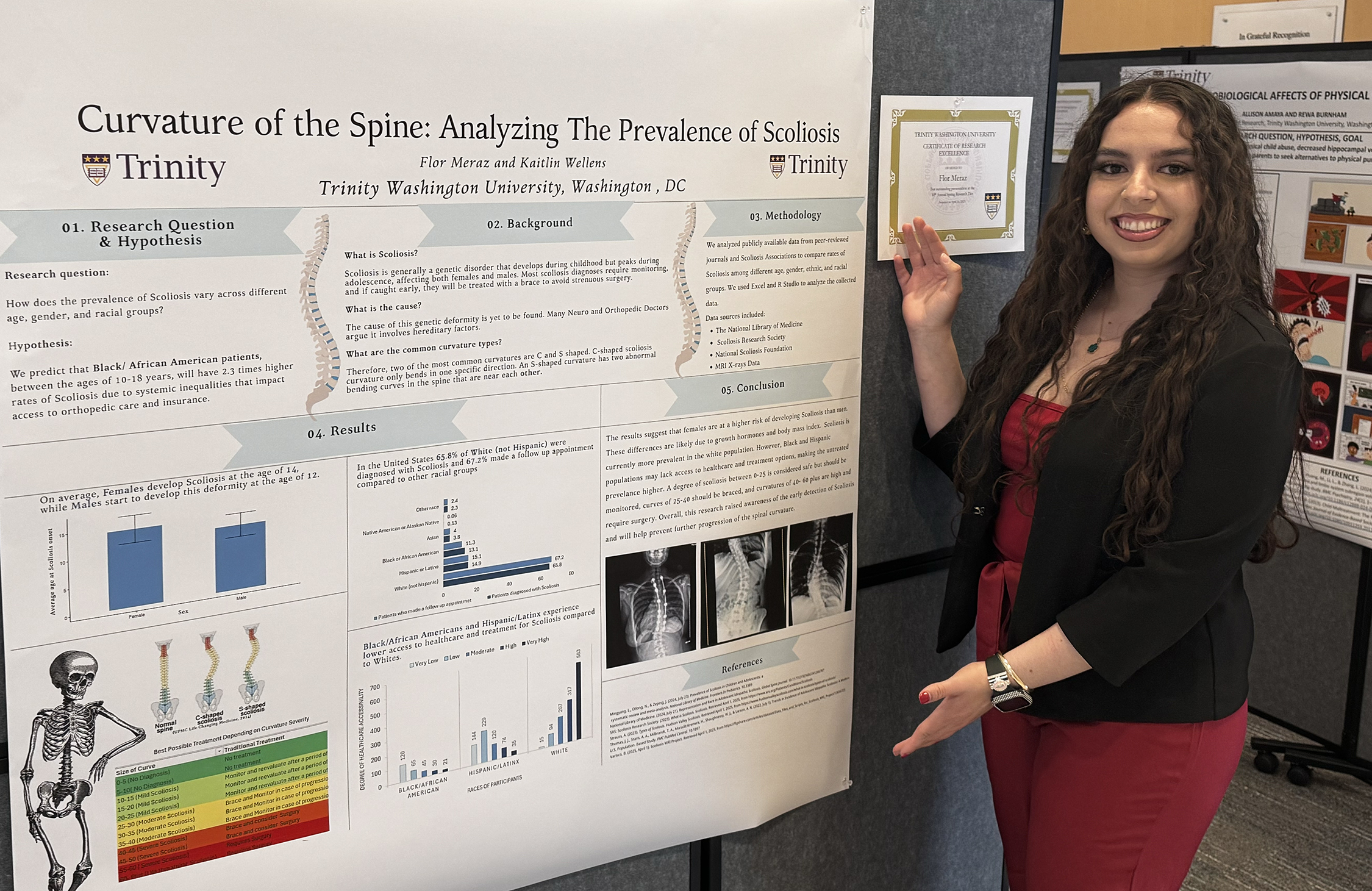
By Saron Gebereegziabhier
Trinity Times Correspondent
When Trinity Washington University biochemistry professor Patrice E. Moss walked into the Payden Academic Center on April 16 for the first day of the 10th Spring Research Day, she marveled at how much the event has grown in the past decade.
Trinity celebrated the 10th anniversary of Spring Research Day (SRD) with the largest and most interdisciplinary showcase in the event’s history. What began in 2014 as an eight-poster session for science majors has grown into a two-day festival of undergraduate scholarship — complete with oral presentations, a marquee panel discussion, and projects spanning everything from global affairs to nursing.
“When I first arrived at Trinity in 2012, one of my goals was to expose our undergraduate science majors to authentic research experiences,” said Moss, associate professor of biochemistry and founder of Spring Research Day. “The presentation of this work was equally, if not more, transformative than the actual research experience. From that premise, Spring Research Day was birthed.”
This year’s SRD featured approximately 45 student presenters from the College of Arts and Sciences. For the first time, the College of Nursing and Health Professions joined the lineup, offering both poster and oral presentations. Faculty from both colleges collaborated on a program centered on “undergraduate creativity and innovation,” with five CAS students joining NHP peers at the lectern.
The formal program opened with “Teamwork Makes the Dream Work: An Interdisciplinary Approach to Solving Real-World Problems.” Although guest panels are a staple of SRD, this year’s speakers struck a particular chord.
“The students were extremely receptive to the panelists and expressed how much they learned,” Moss said, calling the overall event “amazing.”
Among the dozens of posters, biology major Flor Meraz drew steady traffic with her project, Curvature of the Spine: Analyzing the Prevalence of Scoliosis. Meraz’s motivation was deeply personal.
“I have scoliosis myself and had to get surgery because my condition was too severe,” she told Trinity Times.“My X-ray images on the poster — real pictures of my spine before and after surgery — show an S-shaped curve. I had to choose between losing more mobility for full correction or preserving movement by operating only on the worst curve in my upper back. I chose the latter, and it’s been the best decision of my life.”

To conduct her study, Meraz synthesized data from peer-reviewed journals and national scoliosis associations — producing the first project to examine age, gender, and racial factors together in one comprehensive analysis. She found that, on average, females develop scoliosis around age 14, while males present deformities near age 12. She also reported that 65.8% of white patients receive a diagnosis, with 67.2% returning for follow-up care — rates higher than in other racial groups. Black/African American and Hispanic/Latinx patients face significantly lower access to treatment compared to white patients.
“I hope my research will educate the public for earlier detection and spur more support, funding, and healthcare options for those facing scoliosis,” Meraz said.
Another standout came from senior biochemistry major Maria Solache-Nava, whose summer research at the University of California San Francisco’s Fraser Lab produced a catalytically dead mutant of Macrodomain 1 (Mac1) to investigate its role in SARS-CoV-2 biology.
“I originally applied to the Summer Research Training Program on a whim,” Solache-Nava said. “Being accepted was thrilling, but the lab’s recent publications overwhelmed me at first — I experienced impostor syndrome surrounded by peers who seemed more experienced and eloquent about their science.”
Solache-Nava said persistence proved essential. She reviewed background materials thoroughly, asked numerous questions, and repeated DNA mutagenesis experiments until she succeeded.
“I had to accept that experiments often fail on the first try,” she said. “And iterating made each success more meaningful.”
Her research offers new biochemical tools for the field.
“I hope this research deepens our understanding of Mac1’s mechanism and may reveal a potential drug target for treating COVID-19,” she said.
“SRD has become a staple and a treasured tradition for the College of Arts and Sciences at Trinity,” Moss said. “I look forward to learning more about all the great work our students are conducting and how they are contributing to the scholarly fabric of academia every year.”
With its expanded two-day format, new oral presentations, and cross-college collaboration, Spring Research Day looks poised for another decade of growth — one student breakthrough at a time.